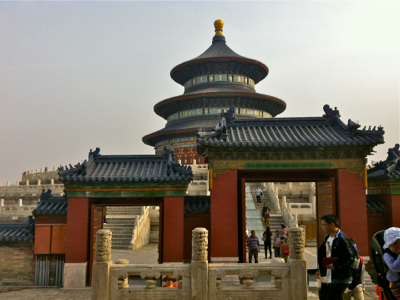
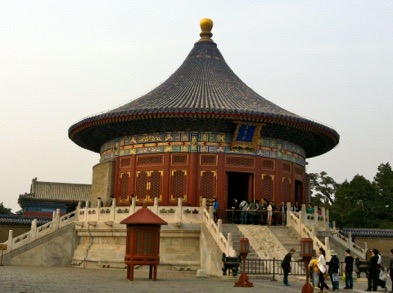
Last weekend we went to look at the Temple of Heaven. We were prompted by a pair of visitors from Bristol who, to quote,”fancied doing the tourist thing” while they were here. Having previously thought all references were another name for a part of the Forbidden City, we went to a map and found that it is indeed a separate entity, though of the same era, further south stretching across nearly 3 sq km, including the delightful park area.
The temple whole has three main constructions, the Hall of Prayer for Good Harvests, the Imperial Vault of Heaven and the Circular Mound Altar. The first is the building with three overlapping roofs (gables?); this was built around 1420 - at the time of the Great Fleet - lost in 1889 to fire and rebuilt shortly after. The second is similar with a single roof, as if the Hall of Prayer was copied and extended. Both of these buildings are bracketed or even framed by rectangular buildings called halls of this and that.
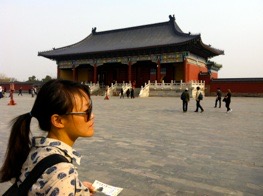
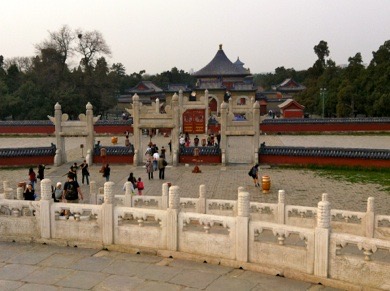
The circular mound (is that tautology?) looks like the first two but waiting for the building. I found this repetition both interesting and amusing - that last because i just know that any Chinese that I might mention such observation to will take instant offence, assuming that the apparent lack in two of the structures causes a loss of face for the nation - and therefore offence. Silly, to a westerner, for whom repetition of a feature serves to emphasise that feature.
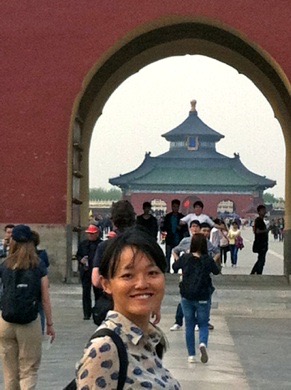
These two are taken from near (left) and upon (right) the mound, the second showing the view towards the South gate. Who’s the nice lady grinning at the camera? Below & left is one from the North Gate, nicely showing the gates folded back within the walls. The mound is laid with flagstones in patterns of nines, each of nine circles being the next multiple of nine flags. I think this is repeated inside the circular buildings as shown below and right.
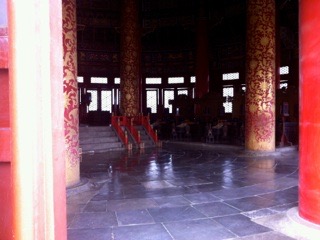
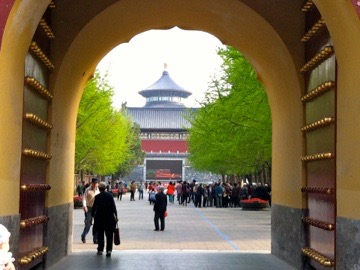
The circular mound has a raised apex in its centre and the tourists, overwhelmingly nationals, queue for their summit photographs. I am certain I missed the significance of this.
Basically, the emperor, being the son of heaven, had to go give thanks to the heavenly powers for the good harvest, including making sacrifices. He made the trip twice a year, no doubt with great ceremony (moving from the Forbidden city to here, staying several days or weeks fulfilling the ceremonial duties). The processions each way were not to be viewed by the populace; the ceremonies had to be perfect (how else does one explain a less than perfect harvest later?). The nines are a reference to the emperor, being presumably on the ninth of nine earthly planes. The whole site is larger than the Forbidden City because the emperor can’t have a place bigger than that dedicated to the heavens.
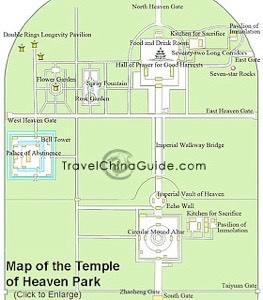
Also on the site is the extensive building called the Palace of Abstinence (interesting that it looks distinctly military, with a moat and bridges) and the Palace of Immolation, where the sacrifices are fed and kept. The mainly green picture showing the site is taken from here¹
This is a cross-section of the central building. The lady is behind, using her camera from within the doorway, whatever you might at first have thought.
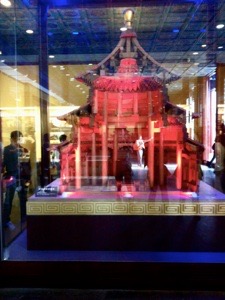
I wondered why the buildings were circular: answer, that ‘heaven is round and the earth is square’.
Off to the east are the seven star rocks or, as the translation has it, the ‘seven meteorites’; we counted eight modern sculptures. That part of the site, as we were there after 19:00. was used by groups of singers. Not too far away, a 100m or so , there were competing singers and erhus in proximity. Why leave the house to play unless you think you’re so good (or so loud) that you must be outside? Why then was the playing of dubious quality? I was taken with a pair of erhu players sat adjacent playing what, to my ears were identical ‘bad’ notes, so presumably they were right and me wrong. I suspect that, not at all by chance, this is the part of the park where the ‘divine music’ is supposed to be.
The blossoms were on the trees and the park was particularly nice. We had arrived fairly late in the day and rushed around the buildings (closing time of 17:30 and already into the last 75 minutes), so we took our time in the park as it was so nice. There are, I read, 60000 varieties of tree (where?, surely not within the park, which is largely the same tree); some are very old (one such below) and have been pruned ruthlessly for reasons I do not understand.
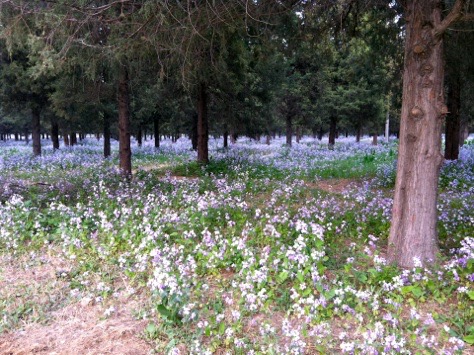
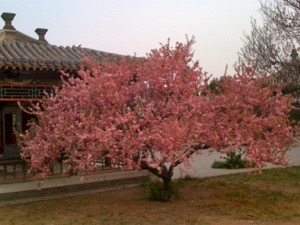
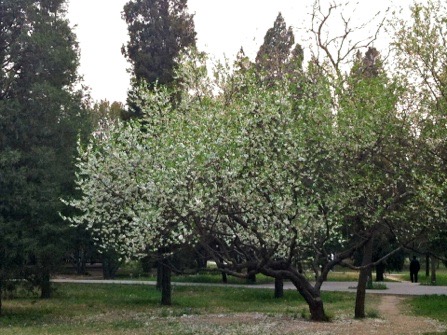
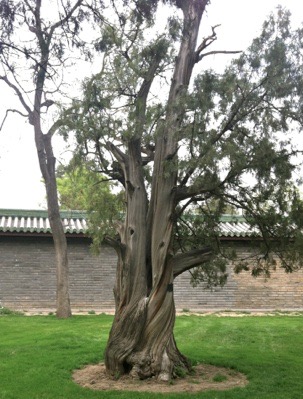
We went back to the same general area the following week, looking at hutongs. The Forbidden City is, as I wrote above, not all that far away, and neither is the wonderfully named WongFuKing (sadly, the k has been swapped for a j in the same way that Peking became Beijing; I found an old photo of a shop front, the WongFuKing Bookstore, now not findable on Google, so I doubt my memory²; also by repute, the wrong effing chemist, shoe shop, tea house, etc.. Wongfujing, the ‘prince’s mansion well’ is the premier shopping area of Beijing, equivalent to Oxford Street in London; we looked in the ‘cotton and silk’ shop, where the prices are about twice what we’ve seen elsewhere (Qingdao, for example). Mind, allowing for rents and so on, that might be pretty cheap. There is a ‘food street’ at the southern end. Opposite the bookstore, where the first few kiosks are selling insects on sticks; the scorpions are waving at you, so when you pick a stick, they go into the fryer while the money changes hands. Delightfully touristy—personally, the density of people is way too high for comfort.
Which reminds me to ask, possibly not for the first time, how do the shops pushing really expensive watches survive? I really don’t see the point of having a second watch, less still the point of paying sums such as £5000 to attract bodily damage and for a device that still only tells the time. Cynthia says I’m missing the point entirely, that this is a way of flaunting wealth; ah, so one would be wearing such a device for everyone else’s benefit? I feel a Monty Python sketch coming on... so if this gives others benefit, why don’t they pay for it? That can’t possibly be right, but I can see why the knock-offs would sell. Many very expensive watches have unpronounceable Swiss-German names, which may well be ‘famous’ in China and not in Europe. I wouldn’t know and could care less. I have learned all sorts of odd combinations of initials as short-hand for ‘famous brand’ that I would not recognise in Britain. Functionality comes first for me, followed by value for money; branding is of little consequence, except where I have personally come to trust a manufacturer’s build quality—Apple; Philips & Panasonic; Ford, Suzuki & Mazda; you will have your own list—but whether you subscribe to buying something because it is a famous brand is something I cannot understand.
DJS 20130505
1 http://www.travelchinaguide.com/attraction/beijing/heaven/
2 Curiously, where wongfuking bookstore used to find an image, now even “wangfuking” finds none on Google. “wongfuking” found hits on here. Is this evidence of political pressure? Is this national level perception of loss of face? Does that mean that, if I were to find my ancient photo, my site will be deleted as if that one photo is ultimate pornography? What has the world come to?